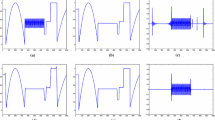Abstract
The image with rich textures can be decomposed into the sum of a geometric part and a textural part. Inspired by this fact, we propose an efficient texture-preserving image deconvolution algorithm based on image decomposition. Our algorithm restores the geometric part and textural part, respectively, by incorporating \(L_0\) gradient minimization and a wave atoms-based Wiener shrinkage filter. The \(L_0\)-based gradient minimization method could globally locate important edges, main structures. The wave atoms transform offers a better representation of images containing oscillatory patterns and textures than other known transforms. Our method contains three steps for restoring texture images. First, we propose an image deconvolution method based on \(L_0\) gradient minimization to restore geometric part of the image with minimal loss of image detail components. Next, we use a Wiener shrinkage filter in the wave atom domain to attenuate the leaked colored noise and extract fine details. Finally, we obtain the estimated image by adding the two image parts together. We compare our deconvolution algorithm with other competitive deconvolution techniques in terms of ISNR, SSIM, and visual quality.







Similar content being viewed by others
References
Wilf, P., Zhang, S., Chikkerur, S., et al.: Computer vision cracks the leaf code. Proc. Natl. Acad. Sci. USA. 113(12), 3305–3310 (2016)
Zhang, S., Lan, X., Qi, Y., et al.: Robust visual tracking via basis matching. IEEE Trans. Circuits Syst. Video Technol. (2016). doi: 10.1109/TCSVT.2016.2539860
Zhang, S., Lan, X., Yao, H., et al.: A biologically inspired appearance model for robust visual tracking. IEEE Trans. Neural Netw. Learn. Syst. 1–14 (2016). doi:10.1109/TNNLS.2016.2586194
Zhang, S., Zhou, H., Jiang, F., et al.: Robust visual tracking using structurally random projection and weighted least squares. IEEE Trans. Circuits Syst. Video Technol. 25(11), 1–1 (2015)
Jiang, F., Zhang, S., Wi, S., et al.: Multi-layered gesture recognition with kinect. J. Mach. Learn. Res. 16(Feb), 227–254 (2015)
Zhang, S., Yao, H., Sun, X., et al.: Action recognition based on overcomplete independent components analysis. Inf. Sci. 281, 635–647 (2014)
Tikhonov, A.N., Arsenin, V.Y.: Solution of Ill-posed problems. Math. Comput. 32(144), 491–491 (1978)
Aghazadeh, N., Akbarifard, F., Cigaroudy, L.S.: A restoration–segmentation algorithm based on flexible Arnoldi–Tikhonov method and Curvelet denoising. Signal Image Video Process. 10(5), 935–942 (2016)
Banham, M.R., Katsaggelos, A.K.: Digital image restoration. IEEE Signal Process. Mag. 14(2), 24–41 (1997)
Yang, J., Yin, W., Zhang, Y., et al.: A fast algorithm for edge-preserving variational multichannel image restoration. SIAM J. Imaging Sci. 2(2), 569–592 (2009)
Purkait, P., Chanda, B.: Morphologic gain-controlled regularization for edge-preserving super-resolution image reconstruction. Signal Image Video Process. 7(5), 925–938 (2013)
Neelamani, R., Choi, H., Baraniuk, R.: ForWaRD–Fourier-wavelet regularized deconvolution for Ill-conditioned systems. IEEE Trans. Signal Process. 52(2), 418–433 (2004)
Hansen, P.Ch.: Rank-deficient and discrete ill-posed problems. SIAM J. Numer. Anal. 35(3), 19–44 (1997)
Dong, B., Shen, Z.: MRA based wavelet frames and applications. IAS Lecture Notes Serier, Summer Program on “The Mathematics of Image Processing”, Park City Mathematics Institute (2010)
Oliveira, J.P., Bioucas-Dias, J.M., Figueiredo, M.A.T.: Adaptive total variation image deblurring: a majorization–minimization approach. Signal Process. 89(9), 1683–1693 (2009)
Li, Xu., Cewu, Lu., Yi, Xu., Jiaya, Jia.: Image smoothing via \(L_0\) gradient minimizatior. ACM Trans. Graph. 30(6), 174 (2011)
Alvarez, L., Gousseau, Y., Morel, J.M.: Scales in natural images and a consequence on their bounded variation norm. Lect. Notes Comput. Sci. 1682(7), 247–258 (1999)
Patel, V.M., Easley, G.R., Healy, D.M.: Shearlet-based deconvolution. IEEE Trans. Image Process. 18(12), 2673–2685 (2009)
Wei, Y., Liu, S.: Domain-based structure-aware image inpainting. Signal Image Video Process. 10(5), 911–919 (2016)
Rzeszutek, R., Androutsos, D.: Propagating sparse labels through edge-aware filters. Signal Image Video Process. 9(1), 17–24 (2015)
Hagag, A., El-Samie, F.A., Amin, M.: Multispectral image compression with band ordering and wavelet transforms. Signal Image Video Process. 9(7), 769–778 (2015)
Portilla, J.: Image restoration through \(L_0\) analysis-based sparse optimization in tight frames. In: IEEE International Conference on Image Processing, pp. 3909–3912 (2009)
Demanet, L., Ying, L.: Wave atoms and sparsity of oscillatory patterns. Appl. Comput. Harmonic Anal. 23(3), 368–387 (2006)
Yang, H., Zhang, Z.: Fusion of wave atom-based Wiener shrinkage filter and joint non-local means filter for texture-preserving image deconvolution. Opt. Eng. 51(6), 351–353 (2012)
Combettes, P.L., Pesquet, J.C.: A proximal decomposition method for solving convex variational inverse problems. Inverse Probl. 24(6), 65014–65040 (2009)
Yang, H., Zhang, Z., Zhu, M., et al.: Edge-preserving image deconvolution with nonlocal domain transform. Opt. Laser Technol. 54(26), 128–136 (2013)
Yang, H., Zhu, MZhongbo Zhang Z., Huang, H.: Guided Filter based edge-preserving image non-blind deconvolution. In: The 20th IEEE International Conference on Image Processing ICIP 2013, Sep (2013)
Huang, H., Yang, H., Ma, S.: Gradient-based image deconvolution. J. Electron. Imaging 22(1), 4049–4068 (2013)
Yang, H., Hu, G., Wang, Y., Wu, X.: Low-rank approach for image nonblind deconvolution with variance estimation. J. Electron. Imaging. 24(6), 063013–063013 (2015)
Demanet, L., Ying, L.: Curvelets and wave atoms for mirror-extended images. Proc. SPIE 6701. Wavelets XII, 67010J (2007)
Villemoes, L.F.: Wavelet packets with uniform time-frequency localization. Comptes Rendus Math. 335(10), 793–796 (2002)
Cands, E., Demanet, L., Donoho, D., et al.: Fast discrete curvelet transforms. Multiscale Modeling Simul. 5(3), 861–899 (2006)
Author information
Authors and Affiliations
Corresponding author
Rights and permissions
About this article
Cite this article
Huang, H., Wang, K. Texture-preserving deconvolution via image decomposition. SIViP 11, 1189–1196 (2017). https://doi.org/10.1007/s11760-017-1074-y
Received:
Revised:
Accepted:
Published:
Issue Date:
DOI: https://doi.org/10.1007/s11760-017-1074-y



